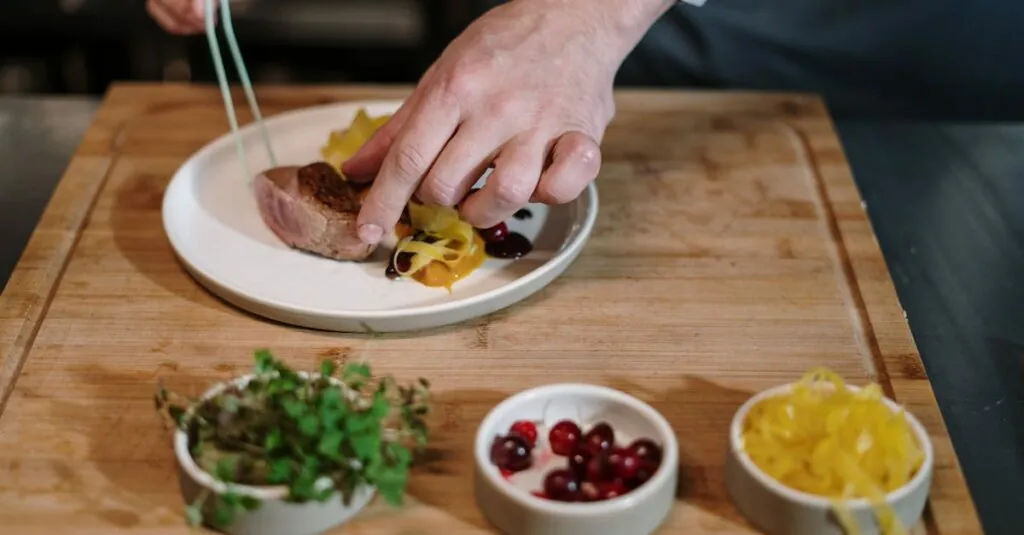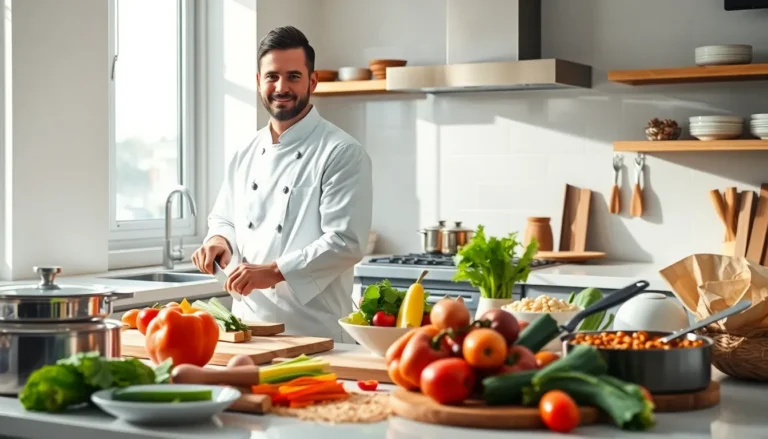Table of Contents
ToggleIn today’s fast-paced world, cooking has transformed from a mundane chore into an exciting adventure. Gone are the days of boiling water and flipping burgers; modern cooking techniques are here to spice things up. Whether it’s sous vide, molecular gastronomy, or air frying, these methods not only make meals tastier but also add a dash of flair to the kitchen.
Overview Of Modern Cooking Techniques
Modern cooking techniques revolutionize meal preparation by blending innovation with tradition. Sous vide involves sealing food in vacuum-sealed bags, then cooking it in a water bath at a precise temperature. This method enhances flavors and preserves moisture, ensuring perfectly cooked meals each time.
Molecular gastronomy takes a scientific approach, transforming textures and flavors through chemical processes. Chefs utilize techniques such as spherification and foaming to create visually stunning presentations and unexpected tastes. Fermentation adds another layer of complexity, using beneficial bacteria to create flavors and preserve food.
Air frying presents a healthier alternative to traditional frying. It circulates hot air to cook food, producing crispy textures with significantly less oil. This method retains flavor while reducing fat content, appealing to health-conscious individuals.
Pressure cooking uses high pressure to cook food quickly while retaining nutrients and flavors. Instant pots, a popular appliance, simplify this technique, making it accessible for busy cooks. Steaming enhances flavor while keeping vital nutrients intact, proving beneficial for health-focused diets.
Grilling and smoking add unique layers of flavor to dishes. Both techniques draw out natural tastes and can transform meats and vegetables into culinary delights. Finally, slow cooking provides convenience, allowing ingredients to meld over an extended period, resulting in deep, rich flavors.
Modern cooking techniques not only save time but also invite creativity into the kitchen. Chefs and home cooks alike experiment with these methods, elevating their culinary experience and enhancing the enjoyment of meals.
Sous Vide Cooking
Sous vide cooking offers precise control over temperature, enhancing flavors and retaining moisture in food. This technique has become popular among both professional chefs and home cooks due to its consistent results.
Benefits Of Sous Vide
Sous vide provides several advantages. First, it preserves the natural moisture of ingredients, ensuring tender results. Second, it locks in flavors, intensifying the taste of meats and vegetables. Third, the precision of temperature control prevents overcooking, allowing for perfect doneness every time. Fourth, sous vide promotes food safety by cooking ingredients evenly at low temperatures. Additionally, the convenience of cooking in vacuum-sealed bags makes meal prep efficient. Also, it allows for infusing flavors by adding herbs and spices directly in the bag.
Equipment Needed
A few essential tools are needed for sous vide cooking. A sous vide immersion circulator maintains the water temperature accurately and ensures even cooking. Food-safe vacuum bags keep ingredients sealed during the cooking process, preventing water from entering. A large pot or container holds the water bath, accommodating various food sizes. A kitchen scale may assist in measuring ingredients accurately. Lastly, a digital thermometer provides an extra layer of temperature monitoring if needed. These tools facilitate successful sous vide cooking, ensuring delicious outcomes every time.
Molecular Gastronomy
Molecular gastronomy combines culinary arts with scientific principles, transforming the way chefs create dishes. This innovative approach changes textures, flavors, and presentations, elevating dining experiences.
Key Techniques In Molecular Gastronomy
Spherification involves creating delicate spheres filled with flavorful liquids. Chefs use sodium alginate and calcium chloride to achieve this effect. Foaming introduces air into sauces and purees, resulting in light, airy toppings. Emulsification combines liquids like oil and vinegar, generating stable dressings and sauces. Sous-vide cooking also plays a pivotal role by allowing precise temperature control, preserving flavors and nutrients. Each technique opens avenues for creativity and encourages chefs to experiment with unconventional elements and pairings.
Popular Dishes
Popular dishes include deconstructed desserts that reimagine classic flavors in surprising forms. For instance, a deconstructed berry cheesecake presents flavors and textures separately, delighting the palate. Another example is the sublime beetroot caviar, which showcases vibrant colors and distinct tastes, captivating guests. The iconic edible cocktail, often created using foaming techniques, surprises drinkers with whimsical presentations and textures. Molecular gastronomy showcases its versatility in savory applications like the famous liquid nitrogen-frozen sorbet, offering a unique dining experience that engages all the senses.
Smoke Infusion
Smoke infusion enhances dishes with complex flavors by incorporating smoky notes. This modern cooking technique appeals to home cooks and professional chefs alike.
Methods Of Smoke Infusion
Several methods exist for smoke infusion. Cold smoking introduces smoke to food without cooking it, preserving delicate flavors. Hot smoking cooks food while infusing smoke, allowing proteins to absorb bold tastes. Additionally, stovetop smoking uses specially designed pans to create smoke indoors. Another option includes using a handheld smoker, which adds smoke directly to dishes for immediate flavor enhancement. Each method allows for experimentation with various wooden chips, such as applewood or hickory, to achieve unique flavor profiles.
Flavor Pairings
Smoke infusion pairs well with numerous ingredients. Meats, especially beef and pork, benefit from enhanced umami flavors when smoked. Vegetables, like eggplant and mushrooms, absorb smoky aromas, creating depth in vegetarian dishes. Seafood such as salmon thrives with a subtle smokiness that complements its natural flavors. Additionally, cheeses like gouda and cheddar gain character from smoke exposure. Incorporating herbs, like rosemary or thyme, introduces freshness while balancing smoky richness. The versatility of smoke infusion allows for endless combinations, encouraging culinary creativity.
Fermentation Techniques
Fermentation techniques enhance flavor while promoting food preservation. This ancient process utilizes microorganisms to convert sugars to acids or alcohol, adding complexity to various foods.
Types Of Fermentation
Lactic acid fermentation transforms vegetables, dairy, and meats into tangy delights. Common examples include sauerkraut, yogurt, and kimchi. Ethanol fermentation creates alcoholic beverages and breads, utilizing yeast for the conversion of sugars. Examples encompass beer and sourdough. Acetic acid fermentation produces vinegar, enhancing flavor in dressings and marinades. Kombucha, a popular fermented tea, showcases a symbiotic culture of bacteria and yeast, offering refreshing flavors. Each type brings unique tastes and textures to culinary creations, inviting experimentation in home kitchens.
Health Benefits Of Fermented Foods
Fermented foods support digestive health, thanks to probiotic properties that maintain gut flora. Numerous studies indicate that these probiotics can improve digestion and enhance nutrient absorption. Consuming fermented foods may also boost the immune system, providing added protection against illness. Additionally, fermentation can increase the bioavailability of vitamins and minerals, making nutrients more accessible. This process often reduces lactose in dairy products, allowing those with lactose intolerance to enjoy them. Regular intake of fermented foods contributes to overall well-being, fostering a balanced diet and promoting holistic health.
Embracing modern cooking techniques opens up a world of culinary possibilities. These innovative methods not only enhance flavors but also streamline the cooking process. Whether it’s the precision of sous vide or the creativity of molecular gastronomy, each technique invites cooks to experiment and elevate their dishes.
The convenience of air frying and pressure cooking caters to busy lifestyles while promoting healthier eating habits. Meanwhile, smoke infusion and fermentation add depth and complexity to meals, enriching the overall dining experience.
As home cooks and professional chefs alike explore these techniques, the kitchen transforms into a place of creativity and adventure. There’s no better time to dive into the exciting realm of modern cooking and discover how these methods can inspire a new approach to meal preparation.



